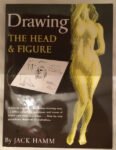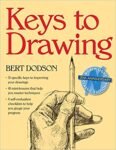This is a 176-page paperback and one of three books on figure drawing that I…

Drawing From Photos, Patrick J. Jones – Book Review
Work still continues on the patio outside and it’s possible that I might not be able to access the studio again until it’s all over but I did manage to sneak in and fetch the last of my birthday books to read, make notes on and review. This is Drawing From Photos by Partick J. Jones, a 160-page paperback with those folded over covers that mean that the corners will never get dog eared.
It’s a book on figure drawing using charcoal (but with ideas applicable to other media), mainly made up of detailed demonstrations. I’d seen a copy in a shop and liked how the demonstrations explained why Patrick did what he did everywhere: they’re the sort of demonstrations that I can learn from. But that’s not really telling the whole story. This isn’t a beginners’ book. It assumes you already know how to draw, how to use charcoal, how to draw figures and how light and shadows work. It’s not even what I’d call a second order book that builds on the basic knowledge and turns you into a better artist. It’s a third order book that assumes you’re already a really good artist and tries to turn you into an excellent one. Looking through some of my other figure drawing books, I think Huston and Legaspi are first order books and that Reid and maybe Buchman are second order, even if Buchman’s more about pushing towards abstraction than about improving your figure paintings. Patrick’s written a couple of other books, both of which sound like they might be quite anatomy focused – these sound to me like second order books and I’ll be watching out for them on Amazon.
There’s no big, fluffy introduction or discussion of materials here. The book’s just divided into eight workshops. The first seven of these are demonstrations and the last one more of an educational piece that should arguably have come at the front rather than the back. The seven demos start off with an objective in mind like learning about light or movement or whatever but there’s a lot more to learn from them than what’s needed to meet the objective, so I won’t list the objectives here. But I will mention the big underlying theme of the demos because it’s the whole point of the book and something that should determine whether you want to but the book. And it’s this. Photos are just an inspiration and not something to be rigorously copied. This comes through in two important submessages. One is that the camera can distort shapes and that you might need to resize some of the body parts around the edges of the photo. The other is that the poses can be suboptimal: sometimes you can make the painting more interesting by (for example) moving a hand or changing the angle of the shoulders. There were other non-compliance ideas in there about swooshy backgrounds and adding bodily adornments but those first two submessages were absolutely key. If you want to see examples of someone doing this, then this could be the book for you. If you’re looking to learn how to exactly replicate photos, then move along please.
There was also a secondary theme coming through about gesture and how blocking in the initial drawing should be based both on structure (so distances, angles etc) and gesture (imaginary swooshing lines connecting everything together). But how it’s important to get the right balance between the two. With my use of grids, I’m guilty of putting far too much weight on structure and not enough on gesture. Or, to put it another way, being too deferential to the source photo. A big learning point for me. There’s a Daniella Brambilla book on figure drawing that is highly focused on gesture that has just shot up to the top of my Amazon wishlist.
It’s also worth mentioning that I found all the references to the use of charcoal to be quite handy too, making this an interesting follow up to the Kate Boucher book. So another book shooting up my Amazon wishlist is an old one on charcoal figure drawing by Douglas Graves. I’m hoping that might leave me better placed to pick up on some of the third order tips in this book.
Anyway, those were the first seven workshops. The book concludes with an eighth workshop that I’d call a lesson rather than a workshop. It’s called “learning to see” and is mainly made up of photos of models with lines drawn on them. They’re the sort of lines that Patrick looks for when studying a pose photo and planning a painting, so they include things like:
– an outline around the figure to help plan where to place it on the paper
– gestural lines
– what would have been vertical lines down the body
– contour lines going around the outside of all the cylinders that the body is (to first order) made up of
– second order contour lines around all the lumps and muscles
This list doesn’t do Patrick justice – you really need to see the annotated photos.
So it’s an interesting book. Definitely not a galactico though. The question is whether to give it three or four stars. I was thinking three stars after I read it but after looking at the volume of notes I took, I think there’s more to learn from this book than I was giving Partick credit for. And I’ll be coming back to this book after reading second order figure drawing books on gesture and anatomy and expecting to find that there’s lots of third order lessons that I missed first time round because this book was too advanced for me. So I’m going to give this one four palettes but with a big warning that you need to already be a really strong figure artist to get the best out of this one. It’s no accident that this book has sent me off looking for what are slightly less advanced books.
⚠️ Warning! 🎨🎨🎨🎨 Danger! ⚠️
You can find this book and more reviews of it at Amazon UK here. As an Amazon Associate, I earn commission from qualifying purchases but this costs absolutely nothing extra to you.








Leave a Reply